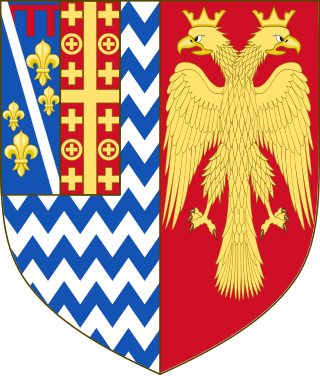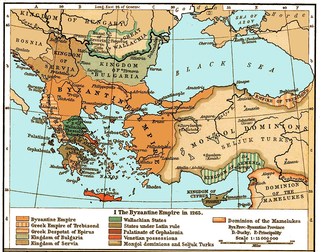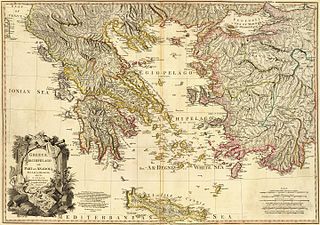Related Research Articles

The Fourth Crusade (1202–1204) was a Latin Christian armed expedition called by Pope Innocent III. The stated intent of the expedition was to recapture the Muslim-controlled city of Jerusalem, by first defeating the powerful Egyptian Ayyubid Sultanate. However, a sequence of economic and political events culminated in the Crusader army's 1202 siege of Zara and the 1204 sack of Constantinople, rather than the conquest of Egypt as originally planned. This led to the Partitio terrarum imperii Romaniae or the partition of the Byzantine Empire by the Crusaders and their Venetian allies leading to a period known as Frankokratia, or "Rule of the Franks" in Greek.

The Duchy of the Archipelago, also known as Duchy of Naxos or Duchy of the Aegean, was a maritime state created by Venetian interests in the Cyclades archipelago in the Aegean Sea, in the aftermath of the Fourth Crusade, centered on the islands of Naxos and Paros. It included all the Cyclades. In 1537, it became a tributary of the Ottoman Empire, and was annexed by the Ottomans in 1579; however, Christian rule survived in islands such as Sifnos and Tinos.

The despot of Epirus was the ruler of the Despotate of Epirus, one of the successor states of the Byzantine Empire in the aftermath of the Fourth Crusade. The name "Despotate of Epirus" and the title "despot of Epirus" are modern historiographical names, and were not in use by the despots themselves. In the Byzantine Empire, the title of despot was a prestigious court title and did not designate rule over some specific territory. Though several of the early Greek rulers of the Epirote realm did use the title of despot, it was never in reference to the lands they governed, but instead in reference to their position in the imperial hierarchy.

Geoffrey II of Villehardouin was the third prince of Achaea. From his accession to the princely throne, he was a powerful and respected person, and even French knights came to the principality to enter his service. Geoffrey II emerged as the most powerful vassal of the Latin Empire of Constantinople, the person around whom the crusaders' states in modern Greece gradually regrouped themselves. He came to the rescue of the imperial capital three times. As a reward of his services to the Latin Empire, he was granted suzerainty over the island of Euboea by his brother-in-law, Emperor Baldwin II of Constantinople (1228–1261). He was also a humane prince, benevolent and just, solicitous for the condition of the common people.

Margaritus of Brindisi, called "the new Neptune", was the last great ammiratus ammiratorum of the Kingdom of Sicily. Following in the footsteps of Christodulus, George of Antioch, and Maio of Bari, Margaritus commanded the kingdom's fleets during the reigns of William II (1166–1189) and Tancred (1189–1194). He probably began as a Greek pirate and gradually rose to the rank of privateer before becoming a permanent admiral of the navy. In 1185, he became the first count palatine of Cephalonia and Zakynthos. In 1192, he became the first Count of Malta. He also held the titles of Prince of Taranto and Duke of Durazzo.

Nicholas Orsini was a Greek–Italian nobleman who was count palatine of Cephalonia from 1317 to 1323 and ruler of southern Epirus around Arta from 1318 to 1323. The son of Count John I Orsini and Maria, an Epirote princess, he succeeded his father upon the latter's death, and in the next year murdered his uncle, Thomas Komnenos Doukas, and usurped his rule of Epirus. While able to secure his control over southern Epirus, however, the north with the city of Ioannina were taken over by the Byzantine Empire. Nicholas' attempts to ally with the Republic of Venice and recover Ioannina failed, and he was in turn killed by his brother John II Orsini in 1323.
Leonardo III Tocco was the last ruler of the Despotate of Epirus, ruling from the death of his father Carlo II Tocco in 1448 to the despotate's fall to the Ottoman Empire in 1479. Leonardo was one of the last independent Latin rulers in Greece and the last to hold territories on the Greek mainland. After the fall of his realm, Leonardo fled to Italy and became a landowner and diplomat. He continued to claim his titles in exile until his death.

The War of the Euboeote Succession was fought in 1256–1258 between the Prince of Achaea, William of Villehardouin, and a broad coalition of other rulers from throughout Frankish Greece who felt threatened by William's aspirations. The war was sparked by Villehardouin's intervention in a succession dispute over the northern third of the island of Euboea, which was resisted by the local Lombard barons with the aid of the Republic of Venice. The Lord of Athens and Thebes, Guy I de la Roche, also entered the war against William, along with other barons of Central Greece. Their defeat at the Battle of Karydi in May/June 1258 effectively brought the war to an end in an Achaean victory, although a definite peace treaty was not concluded until 1262.

The County Palatine of Cephalonia and Zakynthos existed from 1185 to 1479 as part of the Kingdom of Sicily. The title and the right to rule the Ionian islands of Cephalonia and Zakynthos was originally given to Margaritus of Brindisi for his services to William II, King of Sicily, in 1185.

The Frankokratia, also known as Latinokratia and, for the Venetian domains, Venetokratia or Enetokratia, was the period in Greek history after the Fourth Crusade (1204), when a number of primarily French and Italian states were established by the Partitio terrarum imperii Romaniae on the territory of the dismantled Byzantine Empire.
Pietro Zeno, was lord of Andros from 1384 until his death in 1427, and a distinguished diplomat in the service of the Republic of Venice.

The Partitio terrarum imperii Romaniae, or Partitio regni Graeci, was a treaty signed among the crusaders after the sack of the Byzantine capital, Constantinople, by the Fourth Crusade in 1204. It established the Latin Empire and arranged the nominal partition of the Byzantine territory among the participants of the Crusade, with the Republic of Venice being the greatest titular beneficiary. However, because the crusaders did not in fact control most of the Empire, local Byzantine Greek nobles established a number of Byzantine successor kingdoms. As a result, much of the crusaders' declared division of the Empire amongst themselves could never be implemented. The Latin Empire established by the treaty would last until 1261, when the Empire of Nicaea reconquered Constantinople, re-establishing the Byzantine Empire. The various crusader principalities in southern Greece and the Aegean archipelago would last much longer, until they were conquered by the Ottomans in the 14th and 15th centuries.

The Siege of the Castle of Saint George or Siege of Cephalonia occurred from 8 November 1500 until 24 December 1500, when following a series of Venetian disasters at the hands of the Turks, the Spanish-Venetian army under Captain Gonzalo Fernández de Córdoba and Benedetto Pesaro succeeded in capturing the Ottoman stronghold of Cephalonia.
Leo Gabalas was a Byzantine Greek magnate and independent ruler of a domain, centered on the island of Rhodes and including nearby Aegean islands, which was established in the aftermath of the dissolution of the Byzantine Empire by the Fourth Crusade in 1204. He acknowledged some form of suzerainty by the Empire of Nicaea, but remained virtually independent until his death, sometime in the early 1240s.

The Battle of the Echinades was fought in 1427 among the Echinades islands off western Greece between the fleets of Carlo I Tocco and the Byzantine Empire. The battle was a decisive Byzantine victory, the last in the Empire's naval history, and led to the consolidation of the Peloponnese under the Byzantine Despotate of the Morea.

The Ionian Islands were an overseas possession of the Republic of Venice from the mid-14th century until the late 18th century. The conquest of the islands took place gradually. The first to be acquired was Cythera and the neighboring islet of Anticythera, indirectly in 1238 and directly after 1363. In 1386 the Council of Corfu, which was the governing body of the island, voted to make Corfu a vassal of Venice. During the Venetian period the Council remained the most powerful institution on the island. A century later, Venice captured Zante in 1485, Cephalonia in 1500 and Ithaca in 1503. These three islands modelled their administration on Corfu's model and formed their own councils. The conquest was completed in 1718 with the capture of Lefkada. Each of the islands remained part of the Venetian Stato da Màr until Napoleon Bonaparte dissolved the Republic of Venice in 1797. The Ionian Islands are situated in the Ionian Sea, off the west coast of Greece. Cythera, the southernmost, is just off the southern tip of the Peloponnese and Corfu, the northernmost, is located at the entrance of the Adriatic Sea. It is believed that the Venetian period on the Ionian Islands was generally prosperous, especially compared with the coinciding Tourkokratia — Turkish rule over the remainder of present-day Greece.

Richard Orsini was the count palatine of Cephalonia and Zakynthos from before 1260 to his death in 1303/4, and also Count of Gravina in 1284–91. He also served on behalf of the Angevin Kingdom of Naples as captain-general of Corfu in 1286–90 and as the bailli in the Principality of Achaea from 1297 to 1300. He assisted the Despot of Epirus in battle against the Byzantine Empire, and secured the marriage of his son, John I, to the Epirote ruler's daughter, which would lead in 1318 to the Orsini takeover of Epirus.

John I Orsini was the count palatine of Cephalonia and Zakynthos from 1303 or 1304 to his death in 1317. Married to an Epirote princess, John spent a decade at the Epirote court before succeeding his father, Richard Orsini, as count palatine. As a vassal of the Principality of Achaea, he was involved in its domestic affairs and especially the dynastic dispute between the infante Ferdinand of Majorca and Princess Matilda of Hainaut in 1315–16, and participated in a number of Latin campaigns against Epirus, which he aspired to rule. A year after his death, his son and heir Nicholas Orsini seized Epirus and brought it under the Orsini family's rule.
Giacomo Baseggio was a 13th-century Venetian nobleman and administrator.
References
- 1 2 3 Miller 1908, p. 2.
- 1 2 Kiesewetter 2006, p. 339.
- ↑ Setton 1976, p. 3.
- ↑ Kiesewetter 2006, pp. 340–342.
- ↑ Kiesewetter 2006, pp. 339–343.
- ↑ Kiesewetter 2006, p. 343.
- ↑ Miller 1908, pp. 29–30.
- ↑ Miller 1908, pp. 30, 46–47.
- 1 2 Miller 1908, p. 47.
- ↑ Kiesewetter 2006, pp. 345–346.
- ↑ Kiesewetter 2006, p. 348.
- ↑ Jean Longnon L’Empire Latin de Constantinople et la Principauté de Morée, Payot, Paris 1949, p. 175
- ↑ Kiesewetter 2006, p. 351.
- ↑ Setton 1976, p. 65.
- ↑ Kiesewetter 2006, pp. 351–352.